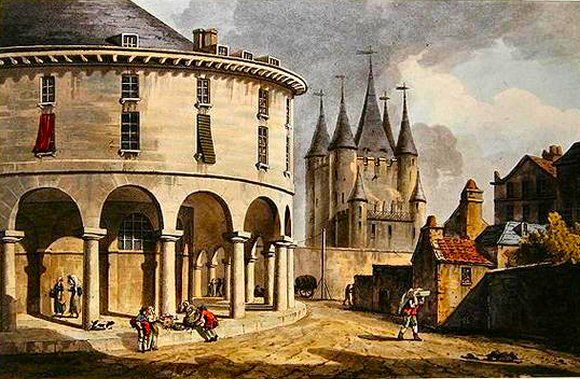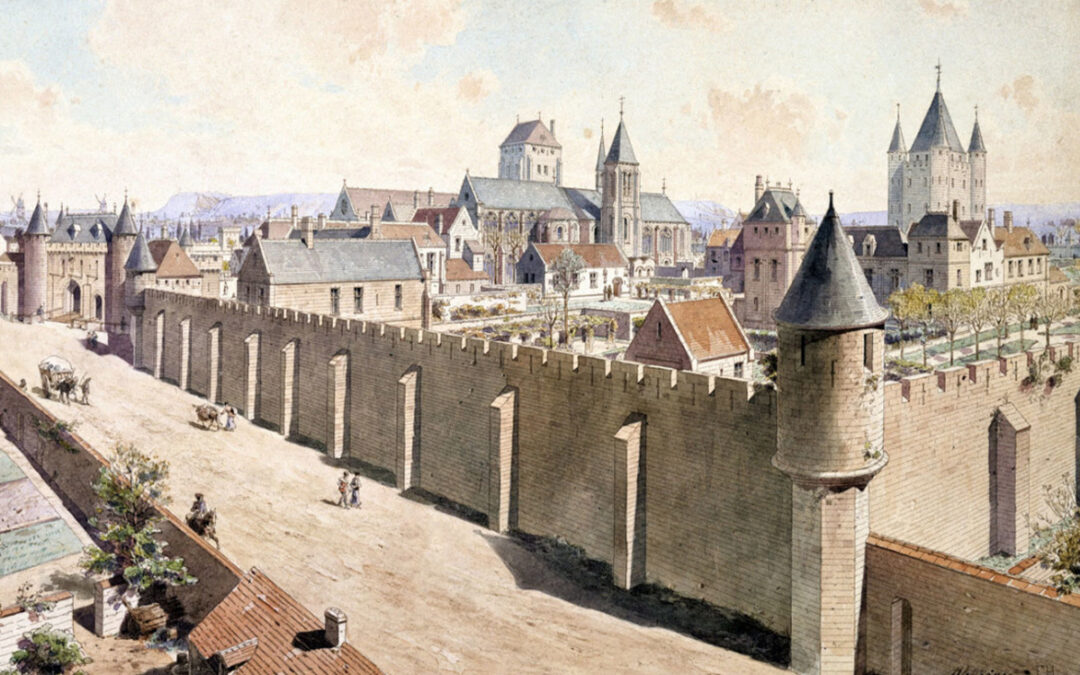The enclosure of the Paris temple in 1450, ©Temple of Paris
On March 18, 1314, the Grand Master of the Order of the Temple, Jacques de Molay, was burned alive. His death ends a trial which lasted seven years and puts a definitive end to the Templar presence in Paris.
King Philippe-le-Bel savors his victory. By eliminating the Templars, he at the same time abolished an order of chivalry which, depending only on Rome, had until then escaped his authority. In addition, the sovereign hopes to kill two birds with one stone by getting his hands on the “Treasure” of the Templars. It must be said that the Order is rich: it has amassed, in two centuries of presence in France, an immense fortune which arouses much covetousness.
It all began at the beginning of the XNUMXth century, in the Marais, with the installation of a first Templar house at what is now rue Lobau, then, later and further north, of a second, which would become increasingly important. considerable and of which the Haut-Marais keeps the memory, in particular through its street or its square “du Temple”.

Square du Temple, ©Anaïs Costet
Since the end of the 6th century, the Templars, expelled from the East, have returned definitively to Europe. In Paris, their “house” now forms an enclosure of around XNUMX ha, protected by a high wall and which houses, in addition to the church, various monastic buildings, a keep, private homes, and… shops!
This is one of the particularities of the Order, which partly explains its wealth: the Temple welcomes into its walls whoever it wishes (it exercises its “right of asylum”); in addition, it applies a “franchise right” for all those who carry out their activity there.
Escaping both the rigidities of the “corporations” and the numerous Parisian taxes, many artisans (upholsterers, cabinetmakers, wigmakers, perfumers, engravers, jewelers, etc.) came to settle “at the Temple” and, in fact, to ensure its reputation and prosperity.
These whet the appetites, that of the king in particular; in January 1307, Philippe-le-Bel finally decided to have the Templars arrested throughout the kingdom. What followed were investigations, trials, convictions for “unnatural practices” and “heresy” and, finally, the dissolution of the Order.
However, contrary to the king's hopes, the fortune of the Templars did not fall into the coffers of the Crown but into those of the Hospitallers (the future "order of Malta"), another company of "monk-soldiers" who then took possession of the “house of the Temple” and will remain there until the Revolution.

Temple district, in 1734, Turgot Plan, 1882
Over time, medieval buildings disappeared and other, more elegant constructions emerged (such as the Grand Prior's palace or, to the east, the “Rotunda”, offering shops and accommodation). In the XNUMXth century, in the gold and paneling of apartments and mansions, sumptuous parties were given, salons were held, “philosophers” were listened to, concerts were attended… This was the “elegant” era. of the “Temple”, which became a crossroads of Enlightenment in Paris.
All this stopped in 1789. As elsewhere, the religious were expelled and the “enclosure” became “national property”; it will subsequently be sold in batches to individuals. Some buildings were destroyed (like the church), others found various uses (ministries, factories, businesses, etc.).
One building, however, suffered a particular fate: in 1792, Louis XVI, Marie-Antoinette and their son were incarcerated in the old dungeon (located on the current site of Rue Spuller). There “Temple Tower” became a high security prison until the death of the king in 1793. On that date, the queen was transferred to the Conciergerie. Only the dolphin remains in the Temple; he died there in 1795.

The Keep and the Rotunda of the Temple, John Claude Nattes, 1808
After the Revolution, the “Tower” caused embarrassment; having become a place of royalist pilgrimage, the dungeon of sinister memory was finally razed in 1811 on the orders of Napoleon I. In the middle of the century, his nephew, Napoleon III, developed the square that we know, then created the district town hall in 1 and, finally, after 1861, on the site of the old rotunda destroyed that year there, “covered markets” made of iron and glass, comparable to the Halles de Baltard in the 1863st arrondissement. Of the six pavilions built, two are still in place and form the “Temple Square”, under which some testimonies of the medieval church and a little of the memory of the Templar brothers still remain today…
FOR PASSIONATES OFUS
Victor Hugo, the writer with a thousand talents
Born in 1802, Victor Hugo became a social writer, a playwright, a poet, a novelist and a romantic designer. Nicknamed the man-ocean then the man-century, he is a political figure and a committed intellectual. He found success with Notre-Dame-de-Paris in 1831 and with Les Misérables in 1862.
Juliette Drouet actress, muse and mistress of Victor Hugo
At 14 rue Sainte-Anastase, from 1836 to 45 and at 12 from 1845 to 48, a few hundred meters from Place des Vosges, lived the muse and lover of Victor Hugo, Juliette Drouet née Julienne Gauvain.
Rue Vieille-du-Temple: the fabulous construction site restarts
A luxury hotel will be created at the end of the work. On the ground floor, the old stables and carriage houses will house the restaurant on the large courtyard, while the first courtyard, on rue Vieille-du-Temple, will feature two businesses continuing its 19th century layout.
NOW ON THE MOOD MARSH
Victor Hugo, the writer with a thousand talents
Born in 1802, Victor Hugo became a social writer, a playwright, a poet, a novelist and a romantic designer. Nicknamed the man-ocean then the man-century, he is a political figure and a committed intellectual. He found success with Notre-Dame-de-Paris in 1831 and with Les Misérables in 1862.
The best tattoo parlors in Marais
Tattooing, an age-old practice, has long been the prerogative of convicts, dock workers, the underworld and sailors. Although it has become democratized, now affecting all profiles and concerning one in five French people, including 16% women compared to 10% men, it still remains taboo due to its definitive and transgressive nature.
Juliette Drouet actress, muse and mistress of Victor Hugo
At 14 rue Sainte-Anastase, from 1836 to 45 and at 12 from 1845 to 48, a few hundred meters from Place des Vosges, lived the muse and lover of Victor Hugo, Juliette Drouet née Julienne Gauvain.





